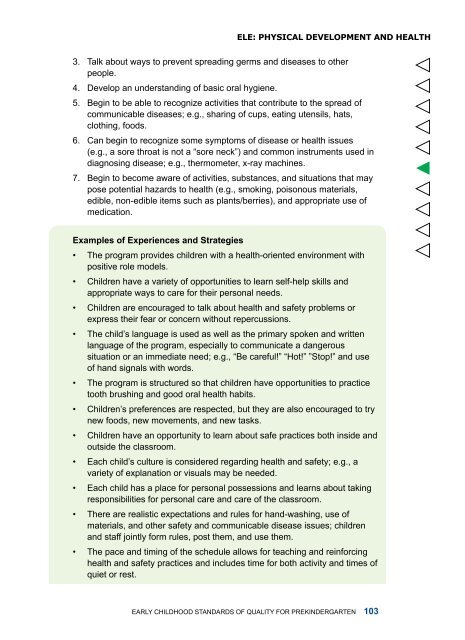Early Childhood Standards of Quality for ... - State of Michigan
Early Childhood Standards of Quality for ... - State of Michigan
Early Childhood Standards of Quality for ... - State of Michigan
You also want an ePaper? Increase the reach of your titles
YUMPU automatically turns print PDFs into web optimized ePapers that Google loves.
ELE: Physical Development and Health3. Talk about ways to prevent spreading germs and diseases to otherpeople.4. Develop an understanding <strong>of</strong> basic oral hygiene.5. Begin to be able to recognize activities that contribute to the spread <strong>of</strong>communicable diseases; e.g., sharing <strong>of</strong> cups, eating utensils, hats,clothing, foods.6. Can begin to recognize some symptoms <strong>of</strong> disease or health issues(e.g., a sore throat is not a “sore neck”) and common instruments used indiagnosing disease; e.g., thermometer, x-ray machines.7. Begin to become aware <strong>of</strong> activities, substances, and situations that maypose potential hazards to health (e.g., smoking, poisonous materials,edible, non-edible items such as plants/berries), and appropriate use <strong>of</strong>medication.Examples <strong>of</strong> Experiences and Strategies• The program provides children with a health-oriented environment withpositive role models.• Children have a variety <strong>of</strong> opportunities to learn self-help skills andappropriate ways to care <strong>for</strong> their personal needs.• Children are encouraged to talk about health and safety problems orexpress their fear or concern without repercussions.• The child’s language is used as well as the primary spoken and writtenlanguage <strong>of</strong> the program, especially to communicate a dangeroussituation or an immediate need; e.g., “Be careful!” “Hot!” ”Stop!” and use<strong>of</strong> hand signals with words.• The program is structured so that children have opportunities to practicetooth brushing and good oral health habits.• Children’s preferences are respected, but they are also encouraged to trynew foods, new movements, and new tasks.• Children have an opportunity to learn about safe practices both inside andoutside the classroom.• Each child’s culture is considered regarding health and safety; e.g., avariety <strong>of</strong> explanation or visuals may be needed.• Each child has a place <strong>for</strong> personal possessions and learns about takingresponsibilities <strong>for</strong> personal care and care <strong>of</strong> the classroom.• There are realistic expectations and rules <strong>for</strong> hand-washing, use <strong>of</strong>materials, and other safety and communicable disease issues; childrenand staff jointly <strong>for</strong>m rules, post them, and use them.• The pace and timing <strong>of</strong> the schedule allows <strong>for</strong> teaching and rein<strong>for</strong>cinghealth and safety practices and includes time <strong>for</strong> both activity and times <strong>of</strong>quiet or rest.<strong>Early</strong> <strong>Childhood</strong> <strong>Standards</strong> <strong>of</strong> <strong>Quality</strong> <strong>for</strong> Prekindergarten 103


